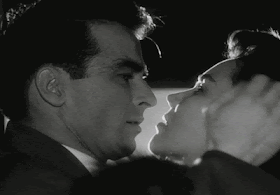Pages
▼
Monday, December 2, 2019
Indiscretion of an American Wife (Vittorio De Sica, 1957)
Indiscretion of an American Wife (Vittorio De Sica, 1957)
Cast: Jennifer Jones, Montgomery Clift, Gino Cervi, Richard Beymer. Screenplay: Cesare Zavattini, Luigi Chiarini, Giorgio Prosperi, Truman Capote. Cinematography: G.R. Aldo. Art direction: Virgilio Marchi. Film editing: Eraldo Da Roma. Music: Alessandro Cicognini.
This plodding romance suffered from the micromanaging of its producer, David O. Selznick, who wanted a big hit for his wife, Jennifer Jones. Director Vittorio De Sica and Selznick fought constantly over the film, and when De Sica's hour-and-a-half version received disappointing comments in previews, Selznick took it out of his hands. Among other things he cut it to a little over an hour and changed De Sica's title, Terminal Station (in Italian, Stazione Termini), to the more blatantly sexy Indiscretion of an American Wife. It was a commercial flop that did nothing for Jones's career. Fortunately, De Sica's cut survived, and it the one more generally seen today. It contains some of the director's neorealistic elements, including the crowds that throng through the film's big set, Rome's railway station. They seem livelier and more real than the lovers played by Jones and Montgomery Clift, a well-to-do Philadelphia woman with a husband and child back in the States, and an Italian academic whose fluent English is explained by his having an American mother. Jones's Mary Forbes has decided to break off their affair and return home, but Clift's Giovanni Doria pursues her to the station, where he makes various attempts to persuade her to stay. They meet various impediments, including Mary's nephew Paul (played by a teenage Richard Beymer), who comes to the station to bring her some things she has left behind and lingers long enough to guess that her aunt and Giovanni are more than just friends -- especially when Giovanni gets so angry that he slaps her. Mary waffles a lot about whether she should stay, and at one point she and Giovanni sneak into an isolated railway car sidelined on the tracks for a last snog, only to be arrested and hauled to the station's police office. The lovers are not very well-drawn, and the scenes between them feel derivative of better movies: There are closeups of the embracing pair that recall the classic ones of Clift and Elizabeth Taylor in A Place in the Sun (George Stevens, 1951), and the railway station setting brings to mind scenes from Brief Encounter (David Lean, 1941). Ultimately we don't feel as involved with Jones and Clift as a couple as we do with the lovers in those movies.
Charles Matthews





